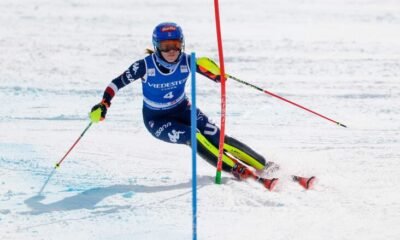Blog
FIS “This is something I never would have imagined at the beginning of the winter”: Alpine skiing’s Next Gen serves notice
Alpine Skiing’s Next Generation: A New Era on the Slopes
At the start of the winter season, few could have envisioned the seismic shifts unfolding on the Alpine skiing circuit. Yet as the snow settled over the high mountain passes and the World Cup calendar unfolded, a new generation of skiers emerged with such power, technique, and determination that established champions took notice. The rallying cry of these athletes—“I couldn’t dream of this at the start of the winter”—has come to encapsulate an era where youthful ambition and untapped talent are rewriting the future of the sport.
A Season of Unprecedented Achievements
The 2024/25 World Cup season witnessed a breakout like no other. In a dramatic reversal of fortune, skiers who had once lingered on the periphery of elite competition propelled themselves into the spotlight. Names that might have been unknown a few months ago became synonymous with victory and brilliance on the slopes.
Among the standout performers were athletes like Franjo von Allmen, Zrinka Ljutic, Alexis Monney, and Camille Rast. Just six months prior to the season, none of these young talents had secured a podium in a major international race. Yet by the season’s end, their names shone brightly—not only with world championship titles and Crystal Globes but also with multiple World Cup victories and podium finishes that stunned the established order. These results were not isolated; an impressive 18 men’s and women’s races were won by competitors aged 25 or younger, and an additional 37 podium placements further underscored the arrival of a generational shift.
One of the most memorable moments came when a rising star, his face beaming with joy after a landmark victory, summed up the season’s incredulity by stating, “Absolutely amazing, I couldn’t dream of this at the start of the winter.” That statement encapsulates the collective disbelief and pride not only of the athletes themselves but also of fans and experts who have long anticipated a turnover in Alpine ski racing’s hierarchy.
The Talent Behind the Breakthrough
Franjo von Allmen: Mastering Speed and Technique
Franjo von Allmen quickly established himself as a force to be reckoned with. The Swiss skier, representing a new wave in Alpine skiing, combined explosive speed with an uncanny ability to read the course, particularly in the high-adrenaline discipline of downhill racing. His technical prowess was evident when he secured multiple victories, including an iconic win at a prestigious downhill event where he demonstrated a blend of fearless descent and precise carving that left spectators and seasoned competitors in awe.
Zrinka Ljutic and Camille Rast: Pioneering the Women’s Circuit
On the women’s side, Croatian phenom Zrinka Ljutic and Swiss rising star Camille Rast emerged as formidable contenders. Ljutic, whose style exuded confidence and technical refinement, battled throughout the season to claim critical victories in slalom and giant slalom races. Her rival, Camille Rast, pushed the boundaries further by not only engaging in head-to-head duels with established names like Mikaela Shiffrin but also by seizing opportunities on the biggest stages. Their competitive interplay became a major storyline of the season, underscoring that the gender gap is narrowing as younger athletes challenge and sometimes even surpass the legacy of veterans.
Alexis Monney and Lara Colturi: From Promising Talent to Consummate Competitors
Further exemplifying the impact of the Next Gen were athletes such as Alexis Monney and 18-year-old Lara Colturi. Monney, who once finished 36th in a race early in the season, reinvented himself with a series of bold, confident performances. His evolution from promising talent to a world championship contender was marked by a dramatic turnaround that saw him reap accolades and even grab a coveted World Championship bronze. Colturi’s breakthrough, on the other hand, was characterized by her swift rise through the competitive ranks, earning multiple podium finishes that signaled her readiness to join the elite category and challenge the sport’s long-standing champions.
Emma Aicher and Lukas Feurstein: Versatility and Consistency
Germany’s Emma Aicher emerged as a particularly versatile competitor. In a season filled with high-caliber performances, Aicher distinguished herself as an athlete capable of excelling across multiple disciplines—from the technical demands of slalom to the high-speed challenges of Super G. Meanwhile, Austrian racer Lukas Feurstein demonstrated that consistency is as much a part of success as raw speed. His measured approach and relentless determination enabled him to secure key podium positions, adding to the growing chorus of voices proclaiming a new era for Alpine skiing.
Redefining the Competitive Landscape
Shifting Paradigms and Coaching Innovations
The swift rise of these young athletes can be attributed to several factors, including innovations in coaching methods, nutritional strategies, and technological advancements in equipment. Training programs have evolved to focus not only on physical conditioning but also on mental resilience—a crucial factor in a sport where margins are razor-thin and the conditions can change in the blink of an eye.
Coaches are now deploying sophisticated video analysis and biomechanical feedback systems that offer skiers real-time insights into their performance. These tools allow athletes to fine-tune their technique and strategically plan runs that maximize both speed and safety, helping them to navigate courses that are often set up to test the boundaries of their physical capabilities.
The Influence of Advanced Equipment and Regulation
Modern ski design and refinements in equipment technology have also played a critical role. The integration of advanced materials and innovative design principles has produced skis and bindings that enable skiers to push the limits of speed while retaining control even on treacherous courses. Although critics argue that equipment alone cannot account for the dramatic improvements, it is clear that when paired with elite coaching and mental preparation, technological innovation acts as a significant multiplier for performance.
At the same time, FIS has undertaken measures to update course setting regulations and safety protocols that ensure the sport remains challenging without compromising the athletes’ well-being. The delicate balance between risk and reward is always at the forefront of discussions among regulators, and the recent season’s success has reinvigorated conversations about how best to protect athletes while preserving the sport’s natural dynamism.
The Broader Impact on the Sport
Inspiring a New Generation
Perhaps one of the most significant outcomes of this breakthrough season is its inspirational power. For young athletes around the world, the success of the Next Gen pioneers is proof that the path to greatness is accessible, regardless of humble beginnings. The achievements of these skiers have captured headlines, energized national ski federations, and, most importantly, ignited the passion of the next generation of aspiring racers.
Federations and sponsors are now looking more closely at investing in talent development programs, with hopes of replicating the success seen on the slopes. The shifting focus has already spurred discussions about increasing resources for youth academies, upgrading training facilities, and ensuring that the infrastructure to support elite performance is in place.
Economic and Commercial Implications
Beyond the inspirational narrative, the meteoric rise of these young athletes carries significant commercial implications. With fresh faces leading the charge, the sport becomes even more marketable. Media coverage has intensified, and the demographic shift towards younger fans is expected to boost television ratings and sponsorship deals.
Broadcast partners and sponsors see the Next Gen as not only the future of the sport but as a catalyst for broader cultural and economic growth. Increased visibility of these athletes during key events drives merchandise sales and enhances the global appeal of Alpine skiing. In turn, these financial injections help sport governing bodies like FIS to invest further in safety measures and athlete development initiatives.
Challenges and Future Directions
Navigating the Pressure of Expectations
However, with great talent comes great pressure. One of the ongoing challenges for the Next Gen athletes is managing the psychological stress that accompanies heightened expectations. Every race is now watched under a microscope, and the weight of carrying an entire new era on their shoulders can be daunting. Mental conditioning and sports psychology are becoming indispensable tools in their training regimens, ensuring that athletes are as resilient off the slopes as they are agile on them.
Maintaining a Balance Between Innovation and Tradition
Another challenge lies in balancing the drive for innovation with the cherished traditions of the sport. Alpine skiing has a storied history, and while modern techniques and technologies push the boundaries of performance, many skiers and fans remain attached to the classic aspects of the sport. The task for coaches, governing bodies, and equipment manufacturers is to integrate these advancements in a way that complements rather than overshadows the rich heritage of Alpine ski racing.
Looking Ahead: What the Future Holds
The momentum generated by this season is poised to influence the sport for years to come. FIS is now considering several initiatives aimed at harnessing the energy of the Next Gen to further innovate and expand Alpine skiing. Potential projects include advanced training programs, strategic international competitions designed to give young athletes more exposure, and even revised course-setting rules that take into account the evolving capabilities of the new generation.
Moreover, long-term investments in youth development are anticipated as national ski federations seek to secure the future of the sport. With increased funding for grassroots programs and enhanced coaching networks, the overall ecosystem is likely to become more robust, ensuring that talent can be nurtured at every level.
Conclusion
The 2024/25 season has proven to be a watershed moment in Alpine skiing. The Next Gen athletes—once outsiders waiting for their breakthrough—have not only arrived but have seized the opportunity to rewrite the narrative of the sport. Their fearless performances, technical brilliance, and resilience on the slopes have set new benchmarks and challenged the traditional power dynamics of Alpine racing.
As these young skiers continue to develop and mature, the landscape of Alpine skiing will undoubtedly transform. The fusion of innovative coaching techniques, advanced equipment, and a renewed focus on athlete welfare promises to create an even more exciting era for the sport. In the words of one jubilant competitor echoing the collective sentiment of the season, “I couldn’t dream of this at the start of the winter”—a powerful reminder that sometimes, the most extraordinary journeys begin from the most unassuming origins.
Inspiring a new generation, attracting fresh investment, and redefining competitive boundaries, the Next Gen represents not just the future of Alpine skiing, but a reimagining of what is possible when passion, innovation, and determination converge on the slopes. The world of Alpine skiing will be watching closely as these rising stars continue to push the limits, turning dreams into reality and setting the stage for many more thrilling chapters in this timeless sport.
This comprehensive look at Alpine skiing’s Next Gen illustrates how a breakthrough season not only disrupts the competitive status quo but also heralds a vibrant future full of promise and innovation.
-

 Blog1 month ago
Blog1 month agoPat Kelsey sends a strong three-word fiery message to the Louisville basketball’s team after their Cardinals 14th win…
-

 Blog1 month ago
Blog1 month agoMikaela Shiffrin responds to cross-country skier Jessie Diggins’ letter following her failure to secure a solitary podium finish at the FIS Nordic Worlds
-

 Blog3 months ago
Blog3 months agoNetflix releases “The Underdog,” a much-anticipated documentary about Drew Brees. slated for publication on the 25th
-

 Blog2 months ago
Blog2 months agoBehind the Turns: Netflix’s Upcoming Documentary on Mikaela Shiffrin’s Fights, Fears, and Love
-

 Blog1 month ago
Blog1 month agoWomen’s Slalom Run 1 at the FIS Alpine Skiing World Cup: Are
-

 Blog3 months ago
Blog3 months agoFederica Brignone: “I’m fine, but my return to skiing is far off.”
-

 Blog3 months ago
Blog3 months agoAlice Cooper: From Fragile Boy to Shock Rock Icon—Netflix Unmasks the Nightmare
-

 Blog1 month ago
Blog1 month agoMikaela Shiffrin sends a two-word message to Lindsey Vonn as she became the oldest woman on the skiing podium
